Two years ago, as part of a collection of articles researching social network site uses, I published a piece (blog post here) about the different predictors of Facebook and MySpace use among a diverse group of first-year college students. Some of the reactions to that paper suggested that the the differences by race/ethnicity and socioeconomic status identified in the data were only temporary and would soon change.
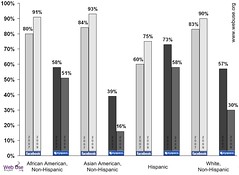 I now have some new data to consider possible changes over the past two years. I haven’t written this up in any formal way yet (nor do I have more elaborate statistical analyses to share right now), but I do have some figures suggesting that the differences I identified two years ago persist today.
I now have some new data to consider possible changes over the past two years. I haven’t written this up in any formal way yet (nor do I have more elaborate statistical analyses to share right now), but I do have some figures suggesting that the differences I identified two years ago persist today.
Note that this is a new cohort of first-year students (i.e., not the same students resurveyed two years later) at the same universitywhere I conducted the study in 2007. (See details about the data collection and sample descriptives at the end of this post.)
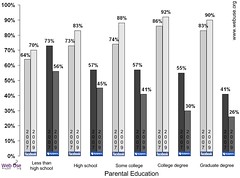 There are two main findings here. (Click on the images for larger versions or see the table below.) First, there is a general increase in use of Facebook and a general decline in use of MySpace across the board. In 2007, 79% of the study participants were using Facebook while in 2009, 87% of the sample reports doing so. In contrast, while in 2007, 55% of the group reported using MySpace, in 2009, only 36% do so.
There are two main findings here. (Click on the images for larger versions or see the table below.) First, there is a general increase in use of Facebook and a general decline in use of MySpace across the board. In 2007, 79% of the study participants were using Facebook while in 2009, 87% of the sample reports doing so. In contrast, while in 2007, 55% of the group reported using MySpace, in 2009, only 36% do so.
Second, we continue to see ethnic and racial differences as well as different usage by parental education (a proxy for socioeconomic status). Students of Hispanic origin are more likely to use MySpace than others and less likely to use Facebook than others. Asian American students are the least likely to be on MySpace. Regarding parental education, the relatively small number (7%) of students in the sample whose parents have less than a high school education are much more likely to be on MySpace and much less likely to be on Facebook than others. Students from families where at least one parent has a college degree are much less likely to be MySpace users than others.
In my 2007 paper, I talked a bit about what may be going on here, but getting deep into that is difficult through data of this sort. danah boyd does much more in-depth work in this realm – granted, on high school students not college students – and has shared reflections both two years ago and just last week on what may be going on.
I welcome suggestions on how to represent this information better (from the table below) on figures as I’m not too happy with my current attempts.
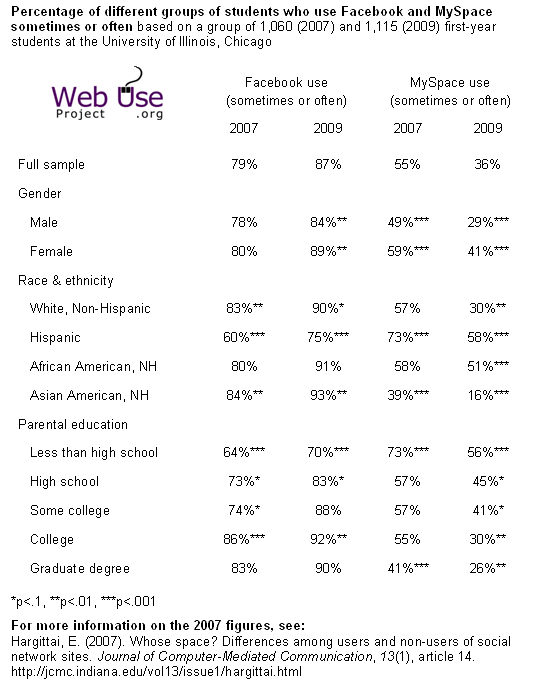
Descriptive statistics about the two samples are below. In both years, we collected data among students enrolled in the one required course at the University of Illinois, Chicago: the First-Year Writing Program. We administered a paper-pencil survey so as not to bias against those who spend less time online or those who are less comfortable with filling out surveys on the Web. The response rate in 2007 was 82%, in 2009 it was 80.5%. The sample here includes first-year students ages 18-24 who took the survey.
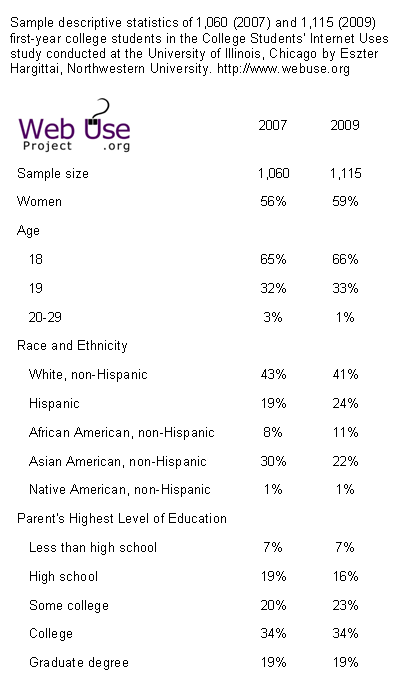
Many thanks go to the fabulous research assistants in the Web Use Project group who were instrumental in the collection of all these data.
UPDATE 7/9/09 6PM CT
I should have clarified that these two samples represent students who are very wired, much more so than the average American adult. The table below shows some basic information about these students’ Internet experiences.
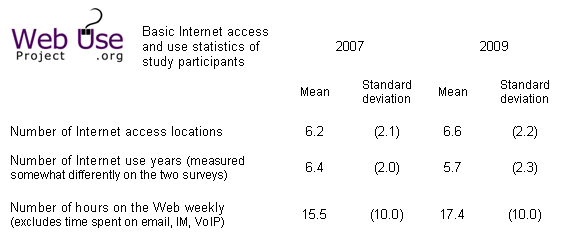
{ 31 comments }
lemuel pitkin 07.08.09 at 7:21 pm
This is great!
I don’t see any evidence, tho, of a digital divide in the usual sense. In fact, what’s striking is how *little* use of social networking sites is affected by the demographic factors you look at here. The Facebook/Myspace average is between 60 and 65 percent for, let’s see, 20 out of 22 subpopulations, which is pretty amazing — and the outlier at the high end is the low-parental-education group in 2007, while the outlier at the low end is the high-parental-education group in 2009.
Of course, if you looked at the proportion using either, the pattern might be different. (Did you do that?) But based on the evidence presented here, one would have to conclude that concerns like those in your previous post are not supported empirically: Class and ethnicity are not significant barriers to internet access, at least among students at a flagship state university.
More generally, are we sure we want to see differences in social networking use by ethnic or demographic groups as prima facie evidence of “privilege” or “exclusion”? (boyd is very emphatic on this point.) It seems to me this logic leads more or less inexorably to seeing any distinct African-American or Latino cultures online as problems to be solved.
One thing I definitely do take from this is that one should be careful with complaints about the tackiness, ugliness, etc. of Myspace pages…
lemuel pitkin 07.08.09 at 7:23 pm
(Sorry, my next to last paragraph was referring to the difference between Myspace and Facebook usage, which does show clear patterns of segmentation by parental education and race — and one wonders how much the former is simply a proxy for the latter.)
Eszter Hargittai 07.08.09 at 7:29 pm
LP, your comment reminds me that I should put in a huge caveat about how this is a very wired group and not representative of Americans in general when it comes to their Internet experiences. In fact, I should add some statistics on that just to be clear. It’s 2:30pm where I am and I haven’t had lunch yet, but once I get back, I’ll do that. I think that should help. Thanks for the reminder.
lemuel pitkin 07.08.09 at 7:30 pm
Ezster,
Point taken. Still this population must be representative of something — else why would you have surveyed them?
lemuel pitkin 07.08.09 at 7:32 pm
Or to put it another way, your finding here — that among college students, parental socioeconomic status has no predictive value for use of online social networking sites — should cause us to revise our priors about the extent of the digital divide downward, no?
sg 07.08.09 at 7:33 pm
Doesn’t this just represent differences in class culture? It probably tracks perfectly with preference for Tennis vs. RAW/WWE.
orr
wY kANt pOOr kIdZ ReeD?
lemuel pitkin 07.08.09 at 7:49 pm
sg-
Right, that was my other point. The abstract of Ezster’s article concludes, “Unequal participation based on user background suggests that differential adoption of such services may be contributing to digital inequality.” The implication is that Facebook and and Myspace are not just different, but “unequal,” i.e. that Facebook is in some way superior to Myspace. And in fact the article clearly conveys the idea that students who use Myspace are worse off than those who use Facebook, tho exactly how is not clear.
But rather than guessing what Ezster is saying, better to ask her directly: Do you think this data is evidence for a digital divide? And is use of Facebook versus Myspace is a form of privilege or exclusion that we should seek to reduce?
StevenAttewell 07.08.09 at 10:45 pm
If the question is Facebook versus Myspace, isn’t it a question of divides within the digital medium, rather than the digital divide (which I always took to mean the divide between those with internet/computer access and familiarity and those without)?
Gene Koo 07.08.09 at 11:01 pm
The issue of “digital divide” is one thing; “digital separation” (in this case, self-imposed) is another. I wouldn’t go so far as to use the term “digital segregation” unless this separation is pernicious (e.g. is job networking happening on Facebook but not MySpace?) but the fact of the difference is important to be aware of.
I’m curious, Eszter, if you can control these results for SES per the previous commentators.
Gene Koo 07.08.09 at 11:09 pm
Also, I may not be reading the table properly, but it’s not clear to me what the statistical significance refers to — is it MS usage between males and females, or MS vs. FB for all males?
Torrie Lane 07.09.09 at 12:41 am
I think online social networking sites like Facebook are a great tool for promotion, but at the very same time the risk associated with the can be huge. Many a person has loss their job due to a poorly place photo.
Randy 07.09.09 at 7:05 am
This is interesting data, but I have to say, it’s no small thing that this is college students. Even if this were a random sample of first year college students and included as many two year college students as four-year, even those students are only about HALF their age cohort (and a percentage that substantial only because these are first year students). To assume that this says anything about the digital divide or about race differences is a humungous sampling error. And Esther, to act as if the boyd sample and your own are differences only in age (rather than age, class, race, and to some extent, gender) would be mistaken as well. It matters to know things about college freshman, but it doesn’t tell you much of anything about the general population. Just saying. People working in universities too often think that their students are representative of the whole population, when they just aren’t.
SusanC 07.09.09 at 11:35 am
@Randy.
I was going to make much the same comment. If the working hypothesis (following danah boyd) is that college students use Facebook and the people who don’t go into higher education use MySpace, it would be good to see survey data that wasn’t just from college students.
Chris 07.09.09 at 3:53 pm
@10: I interpreted it to mean “probability that chance alone would cause this subsample to differ by at least this much from the overall sample on the same question (i.e. head of the column)”. I would expect two-tailed.
As for interpretation, I agree with lemuel that there is not much difference here, but also agree with Randy that the overall sample is not representative and may be a large influence on the results.
Joseph Heath 07.09.09 at 7:14 pm
This is fascinating. Who would have thought that there could be network effects on a social networking site…
Anne Collier 07.09.09 at 8:22 pm
Thanks for this update, Eszter. I wonder about overlap. I keep hearing about youth having multiple social “tools” and profiles – e.g., don’t many Facebook users use MySpace as well specifically for music sampling and sharing? Wonder what you’re seeing.
Anthony 07.09.09 at 10:29 pm
Other than hispanic students, it appears that Facebook is nearly universal among college students now; the big variation is in MySpace use. However, since lots of students use both (at least 20% in all groups except Asian-Americans), it would be interesting to ask which service students used more, or to extract that from the available data.
Eszter Hargittai 07.09.09 at 11:15 pm
Thanks for the engaging comments and good questions.
As I noted earlier in response to lemuel pitkin, I should’ve been more clear about the Internet experiences of people in these two samples. They are in no way representative of Americans as a whole. I have added a table that describes these students’ Internet experiences. These students are very much representative of the so-called “wired generation”. Most of them have been using the Internet regularly for years and have lots of opportunities in their everyday lives to go online and most indeed do so.
Given that we find considerable SES differences in usage even among a group of students whose age and educational level is nearly identical and given that age and education are two of the most salient predictors of Internet usage, were we to look at a more diverse sample, we’d likely find even larger divergences in usage. In that sense, the relative homogeneity of this sample just makes the findings more conservative on those variables.
Addressing Randy’s point about the convenience of this sample, I have to point out that these are not my students. Regular readers of this blog know that I work at Northwestern University. As I’ve tried to point out on the figures, but did not seem to do a good job of in the blog post itself, the students surveyed here are at the University of Illinois, Chicago (UIC). These are two different institutions physically separated by over 20 miles. I have never been affiliated with UIC. The reason I do my studies there – despite the relative inconvenience – is precisely because the student body is so diverse and lends itself well to looking at questions of interest in my work in the domain of digital inequality. Finally, I never said that the only difference between my sample and danah’s is age. In fact, it is precisely that her sample is likely more diverse on SES measures that may lead to her somewhat different findings (larger SES differences, perhaps larger divergences in usage).
lemuel pitkin asked about digital divide issues. Please note that I did not bring up questions about the digital divide anywhere in this post. As StevenAttewell noted, the digital divide tends to refer to users vs non-users. Everybody in these two samples is a user. Most of my work – my previous blog post and some publications notwithstanding – is about the different Internet skills and usage patterns we observe among users not between users and non-users.
I brought up the issue of digital inequality in the 2007 paper in a different context, one concerning use of these sites by those who live with their parents versus those who live on campus. I didn’t take that up in this post at all, I haven’t looked at those data for the 2009 sample so I won’t get into it at the moment.
Gene and others, as I noted, I’m not ready to look at more elaborate statistical analyses, but it is definitely the necessary next step. (I will be writing a paper on these data later this summer, but I have several others plus a book to work on right now and have already been distracted by this material more than I should have been that’s why I’m not going back to it at the moment.)
Gene, regarding the statistical significance you ask about, what that means is that there is a statistically significant difference in the extent to which men and women use Facebook in 2009 (i.e., women use FB more than men). For MySpace, the gender differences are statistically significant in both 2007 and 2009.
Anthony, I have data on use “sometimes†vs use “often†(in the above figures these are collapsed). In the 2007 data, I also have information about use of Friendster, Xanga, Bebo and Orkut. I am working on a paper right now that looks at amount of usage in addition to any use at all both in terms of number of such sites used and frequency of use. I’m not quite ready to share results yet, but I definitely agree with you that asking questions about amount of use is a helpful next step in all this.
Eszter Hargittai 07.09.09 at 11:39 pm
Ooops, I had missed Anne’s comment (for some reason it went into the moderation queue). There is definitely some overlap. That’s partly what I’m looking at in the paper I refer to in my last paragraph above (addressing Anthony’s point). In that paper, I introduce a framework for studying social network site usage that considers both frequency of use and diversity of use.
That said, given the large dip in numbers for MySpace, especially for some groups (like Asian Americans), there are only going to be so many who use both. But yes, it’s definitely something worth looking at!
ajay 07.10.09 at 8:13 am
It would be interesting to compare this with existing information on social networks. I would hypothesise that people join Facebook because they have a lot of friends already on Facebook – right? Now, to take one example, in a highly segregated society, where white people mostly have white friends and Asian people Asian friends, you could well see almost complete difference in use – all the whites on Facebook and all the Asians on Myspace – simply for historical reasons, due to where the early adopters in each group ended up, and their friends and their friends’ friends all followed them.
Perhaps you should repeat this study elsewhere in the country?
Richard J 07.10.09 at 9:25 am
Expanding on this, there’s the enormous popularity of Orkut in Brazil (and pretty much nowhere else) which suggests something about the power of network effects etc.
ajay 07.10.09 at 10:41 am
It was initially the case IIRC that only US college students could use Facebook. Also, anecdotally, Myspace is supposed to be better for posting videos etc than Facebook, so if you have a band, you set up a Myspace page.
dsquared 07.10.09 at 11:41 am
I was told recently that Myspace is basically the online equivalent of Detroit – there’s nobody left there except deadbeats and indie bands.
engels 07.10.09 at 12:43 pm
It was initially the case IIRC that only US college students could use Facebook
Iirc it was originally restricted to students from a small group of colleges, Harvard, Stanford, etc. Ezster, do you only look at usage data or have you ever tried to find out anything about the intentions Facebook’s rulers have or originally had as regards attracting or shutting out people of different classes or ethnicities?
Eszter Hargittai 07.10.09 at 1:46 pm
FYI, NYTimes Gadgetwise now has a piece on all this.
ajay – what you mention is similar to what I discuss in the 2007 paper about how people’s online networks reflect their offline networks. (By the way, your example of Asian Americans on MySpace is curious given that they’re the least likely to be on that particular service as per the figures in the tables. From my 2007 data, it looked like they were the most likely users of Friendster, possibly due to communities in Asia embracing that site more than folks in the US at this point. Given that many of the people in the sample are first or second-generation immigrants, this makes sense.) I do think, however, that it’s interesting to note these differential rates of diffusion for various reasons even if to some they may seem obvious or at least completely understandable. For one thing, many people believe that online, all these background differences disappear. For another, many discussions and analyses of social network sites collapse these sites as though they were all interchangeable and depending on what’s of interest, that’s clearly not the case.
I know that FB was initially restricted to college students only (note, of course, that everyone in my sample is in college, but note also that I consider the implications of the history of FB in the 2007 paper). This was prior to 2006. When I published the data in 2007, people said that the differences I found across groups would soon disappear given that the site had only recently opened up to everybody. They haven’t disappeared two years later though.
I can only cover so much in a blog post. Most of what people bring up are taken on in the 2007 paper and I will likely address again in the forthcoming paper. Of course, it’s fine to ask about it and raise points, just don’t assume I haven’t considered them.
As to the question by engels, I mainly focus on the user’s perspective at this point in my work although in the past I have certainly also looked at how site strategies and features influence what users are most likely to do and be exposed to online (I did this mainly in the domain of search engines and portal sites, I haven’t done a careful analysis of Facebook in this regard).
ajay 07.10.09 at 3:26 pm
25: interesting point about Asian immigrant use of Friendster – so is Myspace really popular in Latin America, explaining the Hispanic anomaly?
24: the intentions Facebook’s rulers have or originally had as regards attracting or shutting out people of different classes or ethnicities?
Blimey.
engels 07.10.09 at 4:05 pm
Ajay, apart from a general sense of having said something that is somehow beyond the pale I’m unable to decipher your meaning. Would you care to elaborate?
engels 07.10.09 at 8:16 pm
Also, I suppose it’s possible that responding to the propositional content of what I wrote rather than plucking a single noun phrase out of the sentence in which it occurs to react with inarticulate shock would be more likely to lead to a productive exchange of views…
agm 07.12.09 at 4:27 pm
@27-28
I’m not sure that there was explicit thought about excluding people based on anything so pedestrian as class or race. Access was restricted so that anyone you saw on facebook was from Harvard. When it was expanded just a little, to schools considered “nearly” equal in pedigree (Stanford, etc) there was much wailing and gnashing of teeth over the loss of exclusivity, which to me says that Harvard students prize their exclusivity but aren’t automatically thinking about deeper implications of what they do all the time.
As Zuckerberg & Co grew the company, more and more schools were added, you saw access grading from students at elite schools to community colleges and so on. When the general internet was given access, there was a particularly big round of wailing and gnashing of teeth: “My father just friended me. Words fail” (actual status of one of my friends) and “Great, I want creepy old men stalking me online.” At least one person has set up a “Your mom” profile to use for jokes.
Multiple site re-designs, the addition of apps, programming APIs, expansion of advertising, rights over all content uploaded by terms of service — it becomes clear that Zuckerber et al seek more ad revenue and view expansion to everyone as the way to get there. Not a strong argument that they are as a company trying to be classist or racist, since they had to abandon their elitism to do so.
engels 07.13.09 at 12:11 am
Well, I never suggested they were motivated by classism or racism. I assume their intention was and is to make as much money they can. But it might be that doing that required thinking about things like the social identity of their user base and trying to keep away people who might ‘lower the tone’ and getting on board people who would set the right tone, as it were. It seems at least possible (to someone like me who isn’t, you will be surprised to hear, a brand consultant or a sociologist) that the class and race characteristics of Facebook’s user base we have been discussing might not be accidental but could be partly the result of a successful strategy on their part, which could have motivated the historical path of its access restrictions.
virgil xenophon 07.13.09 at 4:44 pm
I think you’re on to something, engels. In the early years, say 2004-5, the Friendster and FB crowd seemed to be, imo, dominated mainly by those afflicted with what can only be described as terminal “educated hipsterism,” if from what I gleaned from remarks observed by my admittedly intermittent scanning of blogs written by college-age young at that time is any indication.
Comments on this entry are closed.